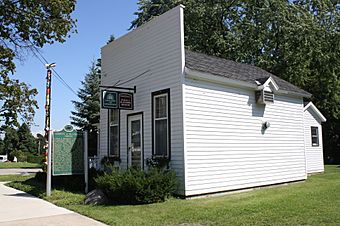Chief Andrew J. Blackbird House facts for kids
Quick facts for kids |
|
|
Chief Andrew J. Blackbird House
|
|

Chief Andrew J Blackbird House (post office section)
|
|
| Location | 368 E. Main St., Harbor Springs, Michigan |
|---|---|
| Area | 1 acre (0.40 ha) |
| NRHP reference No. | 72000611 |
| Added to NRHP | April 14, 1972 |
The Chief Andrew J. Blackbird House, also known as the Andrew J. Blackbird Museum, is a special building in Harbor Springs, Michigan. It is located at 368 East Main Street. This house used to be the home of Chief Andrew Blackbird and his family. Today, it is a museum filled with amazing American Indian artifacts. This house was recognized as an important historical place in 1972.
Contents
History of the Blackbird House
Chief Andrew Blackbird was a very important leader of the Odawa (Ottawa) tribe. He was also a historian, meaning he studied and wrote about the past. He worked hard to protect the rights of Native American people.
Andrew Blackbird wrote a book in 1887. It was called History of the Ottawa and Chippewa Indians of Michigan. He was born around 1815. As an adult, he held several important jobs for the government. For example, in 1861, he became a US interpreter for the Mackinac Agency. Later, in 1869, he was appointed postmaster of Little Traverse, which is now Harbor Springs.
The House as a Post Office
Blackbird bought this house around 1858 for his family to live in. When he became the postmaster, the house also served as the town's post office. People would come to the Blackbird family's kitchen to pick up their mail!
As the town grew, more people moved in. Some new residents did not like picking up their mail in a private home. In 1873, they asked for Blackbird to be removed from his postmaster job. In response, Blackbird built an addition to his house. This new part was just for the post office. However, Blackbird was still removed as postmaster in 1877. He continued to live in the house until he passed away in 1908.
From Home to Museum
After Chief Blackbird's death, his wife, Elizabeth, lived in the house until 1920. Their two sons then lived there until they passed away. The last son died in 1947.
In 1947, the house was sold to the Michigan Indian Foundation. It opened as a local museum in 1948. The City of Harbor Springs bought the house in 1964. They agreed that it would always be used as an Indian museum. Today, it continues to operate as a museum of American Indian artifacts.
What the House Looks Like
The Chief Andrew Blackbird House is made of two parts that are connected. Both parts are 1 and a half stories tall. They are made of wood and covered with white-painted wooden siding.
The original part of the house was built around 1860. It has a porch that goes across the front. The main door opens right into what used to be the kitchen. The second part of the house was added in the early 1870s. This section was used as the post office. It has a special front above the entrance that makes it look taller. This part of the building still has some of the original mailboxes inside! Both sections of the house have a brick chimney.



